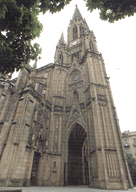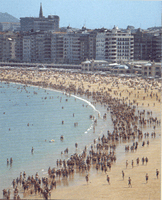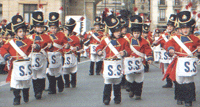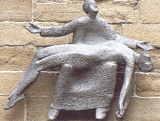|
Just
21km
west
of the
French
border,
within
the
Basque
Country,
lies
Donostia-San
Sebastian,
the
summer
capital
of
Spain.
It
lies
against
the
Bay of
Biscay,
surrounded
by
green
mountains.
During
the
summer
months
the
population
here
swells
as the
Spanish
head
here
to
escape
the
inland
heat.
It has
about
180,000
inhabitants.
San
Sebastian
is a
tasteful
resort
without
the
normal
holiday
resort
trimmings
and
makes
an
ideal
base
from
which
to
explore
the
Basque
Country.
This
is the
capital
of the
province
of
Guipuzcoa,
the
smallest
province
in
Spain.
The
city
offers
quiet,
natural
places
just
minutes
from
the
city
centre
and
the
city
is
divided
into
two by
the
River
Urumea. |
|
|
|
|
|
 |
|
|
|
Getting
to San
Sebastian
is
relatively
easy
as it
is
linked
to
most
of
Spain's
major
cities
by
bus.
The
trains
from
Madrid
to the
French
border
at
Irun
all
stop
here.
Iberia
airlines
also
offer
flights
from
Madrid
to San
Sebastian
airport. |
|
Donostia-San
Sebastian
was
once a
small
fishing
village
and
the
inhabitants
lived
facing
the
sea.
They
were
known
to
have
hunted
whales
and
fished
for
cod.
At one
point
it was
a
thriving
port,
importing
wines
and
oil
for
France
and
England.
Over
the
centuries
the
city
has
undergone
many
sieges
and in
1808
it was
occupied
by
Napoleon's
soldiers
who
stayed
here
until
1813.
The
city
fell
into
decline
in the
19th
century
but
was
lifted
in
1845
when
Queen
Isabel
II
arrived
in the
city
to
spend
the
summer
there.,
a
tradition
that
continued
for
decades.
|
|
|
|
|
|
 |
No
visit
to the
city
is
complete
without
a
visit
to the
old
quarter
(Parte
Vieja)
where
most
of the
traditional
local
life
takes
place.
Its
narrow
streets
are
packed
with
bars
and
restaurants.
The
Plaza
de la
Constitución
is
where
you
will
find
the
library,
once
the
Town
Hall.
The
square
was
once
used
as a
bullring.
The
Basilica
of
Santa
Maria
del
Coro,
patron
saint
of the
city
can be
found
on the
only
street
that
remains
from
the
1813
fire,
the
Calle
31 de
Agosto.
The
old
quarter
opens
out to
the
sea at
the
harbour,
home
to the
fishing
fleet
as
well
as the
pleasure
craft.
Here
you
will
find
the
Naval
Museum
and
the
Aquarium.
|
|
 |
|
|
Donostia-San
Sebastian
has
three
beaches,
La
Concha,
Ondarreta
and La
Zurriola.
La
Concha
was
made
popular
by
Queen
Isabel
and is
considered
to be
one of
the
most
beautiful
city
beaches
in
Europe.
Ondarreta
beach
stands
at the
foot
of
Mount
Igeldo
and
has a
more
aristocratic
feel
to it
because
of the
villas
and
gardens
that
lead
to the
sand.
La
Zurriola
is to
be
found
on the
right
bank
of the
river
and
has
undergone
a
massive
project
to
increase
its
size
by
reclaiming
land
from
the
sea.
It is
now
much
bigger
than
La
Concha
beach.
All
three
beaches
offer
tourist
changing
rooms,
parasols
and
sun
beds.
Standing
in the
centre
of La
Concha
Bay is
the
tiny
Santa
Clara
Island
with a
lighthouse
and a
small
wharf.
This
island
turns
into
the
city's
fourth
beach
in the
summer
with a
ferry
service
from
the
harbour. |
 |
|
|
There
are
many
monuments
to
explore
in the
city,
such
as the
Cathedral,
a
neo-Gothic
structure
of the
19th
century.
Its
spire
at 75m
high
can be
seen
from
most
of the
city.
On
Mount
Urgull
you
will
find
the
Castillo
de la
Santa
Cruz
de la
Mota
which
stands
on the
site
of an
earlier
fort.
All
over
the
city
you
will
find
open-air
sculptures
by
local
artists.
The
city
also
offers
several
parks
and
gardens.
Wide
open
spaces
of
green
with
manor
houses
and
water
features.
Wandering
round
the
shops
will
probably
prompt
you to
indulge
in one
of the
local
Basque
products
such
as
cotton
shirts
and
berets.
Paseo
de
Muelle
is the
best
shopping
area
where
you
will
be
able
to buy
almost
anything.
The
sunsets
in San
Sebastian
can be
spectacular,
as is
the
nightlife.
Much
of the
nightlife
is
based
in the
old
quarter,
as are
most
of the
best
restaurants.
They
offer
a wide
selection
of
cuisine
but
seafood
is the
speciality. |

 |
|
|
The
north
of
Spain
is
becoming
increasingly
attractive
to
other
Europeans
as the
southern
part
of
Spain
is
bursting
at its
seams
but if
you
intend
to buy
a
property
here
then
be
prepared
- its
by no
means
as
easy
as it
is in
the
south.
Most
agents
speak
very
little
English.
San
Sebastian
is,
with
Madrid,
the
most
expensive
city
in
Spain!
houses
are
very
expensive!
The
city
offers
fiestas
and
celebrations
throughout
the
year,
without
break,
some
of the
best
are:
January
20th -
San
Sebastian
Day.
The
patron
saints
day
with
parades.
Two
cross-country
races
February
Tinkers
Parade,
prelude
to the
carnival
Nursemaid's
and
Shepherd's
Day
Carnival,
a
celebration
popular
since
1978
March
Domingo
de
Piñata
Horse
racing
season
starts
April
second
fortnight
is the
book
fair
Music
festival
and
festival
of
Andalucian
folklore
May
Dia de
las
Casas
Regionales
-
different
regions
of
Spain
on
display
June
23rd-24th
San
Juan
night
with
bonfires
to
mark
the
start
of
summer
July
Festival
of
Jazz
Theatre
fair
August
Semana
Grande
- Day
of the
Virgin
International
fireworks
competition
Fiesta
del 31
de
Agosto
-
marking
the
fire
of
1813
September
Rural
sports
and
folklore
fair
International
Film
festival
October
Fantasy
and
Horror
Film
Festival
November
Marathon
December
21st -
Feria
de
Santo
Tomás
Arts
and
crafts
market
31st -
San
Silvestre
footrace
|
|
|
The
city
also
offers
the
visitor
a
selection
of
museums,
six in
all
and
when
you
have
explored
enough,
try
the La
Perla
Talasoterapia
sea
spa
centre
where
you
can
relax
in
therapy
pools,
saunas
and a
Jacuzzi.
For
the
energetic,
the
Mount
Igeldo
attraction
park
offers
over
30
attractions
and
the
ice
skating
rink
is a
great
visit.
You
will
also
find
casinos
and
bingo
halls.
The
best
way to
explore
the
city
is by
tourist
bus or
the
train. |
 |
|
| |
|
|

